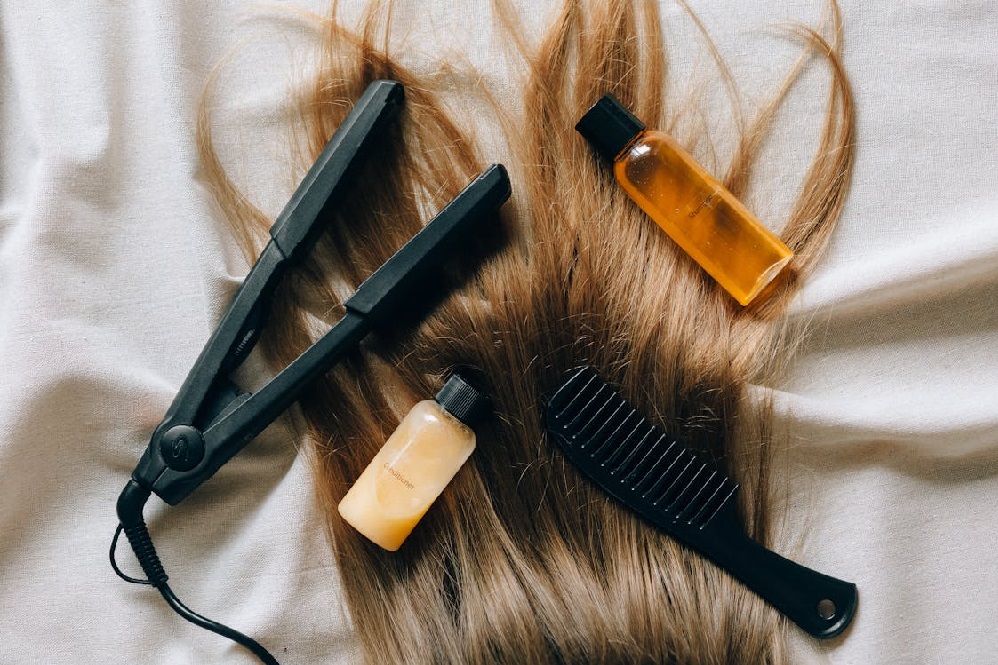For countless individuals, achieving a smooth, straightened mane is a part of their daily hair routine. Hair straightening machines, also known as flat irons, have become a popular tool to transform curly, wavy, or frizzy hair into a smooth, polished look.
But how exactly do these devices work, and are they safe for everyday use? Let’s delve into the science behind hair straightening machines and explore how to use them effectively with minimal damage.
How Hair Straightening Machines Work: A Breakdown
At the heart of a hair straightening machine lies the power of heat. The device utilises a heating element, typically made of ceramic, tourmaline, or titanium, to reach desired temperatures. When you clamp down on a section of hair with the heated plates, the heat disrupts the hydrogen bonds within the hair’s keratin structure. These bonds are responsible for the hair’s natural curl pattern.
Let’s dive deeper into the process of straightening:
- Heat Disruption
As the heated plates come in contact with the hair strand, the heat disrupts the existing hydrogen bonds within the hair’s cortex, the inner layer responsible for its shape.
- Reshaping
With the hydrogen bonds broken, the hair becomes more malleable. As you glide the hair straightening machine down the hair shaft, you essentially reshape it into a straighter form.
- Cooling and Setting
Once the hair cools down, new hydrogen bonds form, locking the hair in its straightened state.
Factors to Consider for Safe Daily Use of Hair Straightening Machines
While hair straightening machines offer a convenient way to achieve straight styles, it’s crucial to prioritise healthy hair practices. Here are some key factors to consider for safe daily use:
- Heat Settings
Not all hair types are created equal. Fine hair requires lower heat settings (around 290°F to 300°F) compared to coarse or thick hair (which can handle temperatures up to 300°F to 340°F). Using the appropriate heat setting minimises heat damage.
- Heat Protectant Spray
A heat protectant spray acts as a shield, forming a barrier between your hair and the hot plates. This helps reduce heat damage and protects the hair’s natural moisture.
- Application Technique
Avoid holding the hair straightening machine on a single section of hair for too long. Glide the straightener smoothly down the hair shaft with minimal passes to minimise heat exposure.
- Hair Condition
The condition of your hair significantly impacts how well it holds a straightened style. If your hair is already dry or damaged, consider using a hair straightening machine less frequently and focus on deep conditioning treatments.
Finding the Best Hair Straightener for You
With a vast array of hair straightening machines available, choosing the best hair straightener depends on your specific hair type and styling needs. To navigate your options effectively, consider these crucial features:
- Plate Material
Ceramic, tourmaline, and titanium are popular plate materials. Ceramic plates distribute heat evenly, tourmaline is known for its ionic properties to reduce frizz, and titanium heats up quickly and maintains consistent heat.
- Temperature Settings
Look for a hair straightening machine with adjustable temperature settings to customise the heat based on your hair type.
- Plate Size
The size of the plates determines the amount of hair you can straighten in one pass. Wider plates are ideal for thick or long hair, while narrower plates offer more control for styling fringes or shorter hair.
- Additional Features
Some hair straightening machines come with additional features like automatic shut-off, ionic technology for frizz control, or digital temperature displays for precise control.
Beyond the Basics: Advanced Technology in Best Hair Straightener
While traditional hair straightening machines deliver results, advancements in technology have led to the development of innovative tools that prioritise healthy hair styling. The best hair straightener often incorporates features that minimise heat damage and promote hair health. Here are some examples of advanced hair straightening technology:
- Flexing Plates
Some straighteners feature flexing plates that conform to the shape of your hair, ensuring even heat distribution and reducing the need for multiple passes.
- Intelligent Heat Control
The best hair straightener may come equipped with intelligent heat control systems that automatically adjust the temperature based on your hair type and thickness. This minimises heat exposure, promoting healthier-looking hair.
- Heat Damage Repair Features
Certain hair straighteners incorporate features like negative ion technology or conditioning treatments that aim to minimise heat damage and promote hair health during styling.
Achieve Straight Hair with Confidence
By understanding the science behind how hair straightening machines work and prioritising safe practices, you can achieve sleek, straight hair without compromising the health of your locks.
Dyson’s Corrale hair straightener might be the best hair straightener for you if you’re looking for an advanced approach to straightening your hair. Explore their features to see if they align with your hair care goals.
By combining an understanding of hair science with innovative technology, you can achieve your desired hairstyle while prioritising the health and beauty of your hair.

